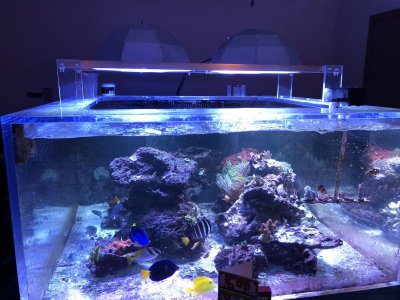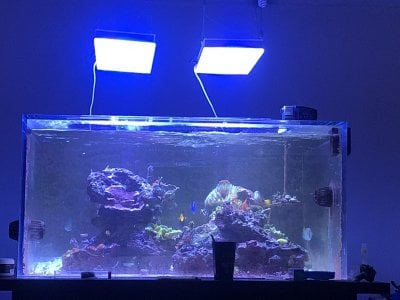Linear flow is great for fish - the use very little energy in constant flow. In random flow they have to work a lot more.
Navigation
Install the app
How to install the app on iOS
Follow along with the video below to see how to install our site as a web app on your home screen.
Note: This feature may not be available in some browsers.
More options
You are using an out of date browser. It may not display this or other websites correctly.
You should upgrade or use an alternative browser.
You should upgrade or use an alternative browser.
Lets Talk about FLOW and SPS!
- Thread starter HotRocks
- Start date
- Tagged users None
I have found that you need to be competent, but beyond this does not do much. I have a 240 with a Tunze 6200 series and a 6105 and a REAL Wavebox. This is competent. I used to use 6100s and then 6105s and they were competent too.
Competent flow is hard to determine, but enough so that your fish cannot just sit there without "swimming" and having a decently random flow both with velocity and location. I do not consider only gyre flow to be very competent in my tanks... pattern is too static even if I can change the velocity.
In my tank, the wavebox does the heavy lifting moving the entire 240 gallons back and forth a few inches every few seconds. The work that these do is amazing and I would likely never run a tank without one. The flow pumps are just to move around the stuff that the wavebox keeps suspended.
I agree, I would never use a gyre style pump in a tank by itself. I have been wanting to add a wavebox but keep putting it off. I use an ocean motion with a wave puck pump on constant to break things up and pulse on the other pumps. I still feel like a wave box would be an upgrade though.
My optimal setup would be two ocean motions on either end with good pumps with wide flow pattern on them and a wavebox as my main flow.
I haven’t looked for a while but are other companies making decent versions of the tunze box?
Over the years I have certainly noticed that some Acros like more flow than others. Some will lean into the flow while others away. My Millies, tables my blue matrix all seem to prefer fairly high (random) flow.
My gyre xf350s are random flow, 100% up and down in my Red Sea 425xl and my corals love it... SPS, LPS and softies.
I use 4 MP40’s in my 48/48 cube. One on each side pane and 2 on the back. They are controlled via my WXM. they run through different modes all day and different intensities. Sometimes the bulk of the movement is back to front, sometimes left to right and sometimes right to left. Then for a few hours each day they all run 100% constant to get any debris suspended.
then on the overflow box I run an old gyre 150 on about 65% constant. this provides good flow down the center of my tank in the ravine I have built that is protected somewhat from the vortechs since there is nowhere to mount them.
i think as stated, random flow is what is best, not so much “xx turn over”
corey
then on the overflow box I run an old gyre 150 on about 65% constant. this provides good flow down the center of my tank in the ravine I have built that is protected somewhat from the vortechs since there is nowhere to mount them.
i think as stated, random flow is what is best, not so much “xx turn over”
corey
2 MP40s on nutrient transport on antisynce (reduced or mixed up at night), 1 seaswirl return, and 1 seasweep = the best flow with zero deadspots
HotRocks
Fish Fanatic!
View Badges
Staff member
Super Moderator
Excellence Award
Reef Tank 365
Expert Contributor
Article Contributor
INDMAS Member
My Tank Thread
This is basically what I just switched too. Slightly lower outside of photoperiod. I have the same exact tank and gyresMy gyre xf350s are random flow, 100% up and down in my Red Sea 425xl and my corals love it... SPS, LPS and softies.
I’d love to see your 48” cube. That sounds like my dream tankI use 4 MP40’s in my 48/48 cube. One on each side pane and 2 on the back. They are controlled via my WXM. they run through different modes all day and different intensities. Sometimes the bulk of the movement is back to front, sometimes left to right and sometimes right to left. Then for a few hours each day they all run 100% constant to get any debris suspended.
then on the overflow box I run an old gyre 150 on about 65% constant. this provides good flow down the center of my tank in the ravine I have built that is protected somewhat from the vortechs since there is nowhere to mount them.
i think as stated, random flow is what is best, not so much “xx turn over”
corey
On my 120 I use 2 tunze 6095's on the back wall and 2 jebao ow-25's on the sides.
All are around 2500 gph.
They currently run on pulse mode around 5 seconds.
This create nice flow so far.
May need to adjust when the tank grows out.
Only 4 months old.
Have 2 more 6095's but wanted to se how long the jebaos last. So far they semm ok. I clean all pumps once
 a month. May be overkill but it is easy to do.
a month. May be overkill but it is easy to do.
All are around 2500 gph.
They currently run on pulse mode around 5 seconds.
This create nice flow so far.
May need to adjust when the tank grows out.
Only 4 months old.
Have 2 more 6095's but wanted to se how long the jebaos last. So far they semm ok. I clean all pumps once
I am around 60+ the exact amount I am not sure of since ~60x is the max speed set for each wavemaker (Assuming AI #s are valid) but they are alternating in pulse mode so there is a bit of overlap.
Just frags so when they get bigger, that may need to go up.
Basically as long as the polyps are moving and the fish are not stuck against the glass I think its fine. My LPS doesn't seem to care either, duncan has a permanent bad hair day.
Just frags so when they get bigger, that may need to go up.
Basically as long as the polyps are moving and the fish are not stuck against the glass I think its fine. My LPS doesn't seem to care either, duncan has a permanent bad hair day.
Here are Few pictures @Chaswood79 the picture with halides on it is older. The one with the 2 Orpheks is from July when I switched.
that switch has been a huge struggle and I’ve lost a few SPS pieces, but that’s a different story...
trying to get them to grow out like yours buddy!
corey


that switch has been a huge struggle and I’ve lost a few SPS pieces, but that’s a different story...
trying to get them to grow out like yours buddy!
corey


YepHere are Few pictures @Chaswood79 the picture with halides on it is older. The one with the 2 Orpheks is from July when I switched.
that switch has been a huge struggle and I’ve lost a few SPS pieces, but that’s a different story...
trying to get them to grow out like yours buddy!
corey


That’s my dream tank. I would have to convince my wife that we don’t really need the dining room table anymore and I’m pretty sure she would not agree, but that looks perfect. Sorry for thread derail and thanks for sharing
One thing to note in the BRS video, is the small coral frags they are using for the test. I would postulate the results would vary greatly when using colony sized specimens.
I'm surprised that this was not part of the discussion.
I'm surprised that this was not part of the discussion.
One thing to note in the BRS video, is the small coral frags they are using for the test. I would postulate the results would vary greatly when using colony sized specimens.
I'm surprised that this was not part of the discussion.
Totally agree!
Flow is one of the big hurdles with keeping wild collected dense skeleton or tightly knit colonies happy. Where as a frag/nubbin of the same species will readily adapt to lower flow/ different flow dynamics.
Some of these colonies are collected from incredibly high energy environments/parts of the reef, where the whole column of water around the coral is shifting constantly. Recreating that type of mass water movement is incredibly hard in reef aquariums.
Surge devices and wave boxes can sort of get you close though.
with acropora esp, I always determine the flow a coral is going to receive based on three things- its species, the area that species prevails on the reef and its structure-branch thickness/density of branches.
Just my two pennies! Great topic btw!
HotRocks
Fish Fanatic!
View Badges
Staff member
Super Moderator
Excellence Award
Reef Tank 365
Expert Contributor
Article Contributor
INDMAS Member
My Tank Thread
All very valid points you make! I agree it’s a great discussion and I am learning a lot just reading through the posts!Totally agree!
Flow is one of the big hurdles with keeping wild collected dense skeleton or tightly knit colonies happy. Where as a frag/nubbin of the same species will readily adapt to lower flow/ different flow dynamics.
Some of these colonies are collected from incredibly high energy environments/parts of the reef, where the whole column of water around the coral is shifting constantly. Recreating that type of mass water movement is incredibly hard in reef aquariums.
Surge devices and wave boxes can sort of get you close though.
with acropora esp, I always determine the flow a coral is going to receive based on three things- its species, the area that species prevails on the reef and its structure-branch thickness/density of branches.
Just my two pennies! Great topic btw!
This may be the worst quality video I’ve ever seen but I have no idea what I’m doing. Please don’t be too harshEasiest way to upload a video is upload yo YouTube and then post the link and it will embed the video into your post.
@Chaswood79 i am envious as always of your PE. I have none. Ever.
I also have 2 dwarf angel fish
corey
I also have 2 dwarf angel fish
corey
Then you would love the PE I have on all of my new “FREE” aptasias
Nice vid @Chaswood79 When are you going to convince your better half to get rid of those ugly P.mutuki's? 
Similar threads
- Replies
- 14
- Views
- 897
- Replies
- 15
- Views
- 500
TOP 10 Trending Threads
- Replies
- 24
- Views
- 141
New Posts
-
-
SBB - AFTERPARTY SALE- 3 day event 1750 corals. Our Largest sale ever!
- Latest: SBB Corals



















